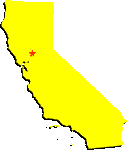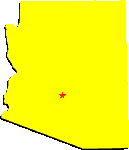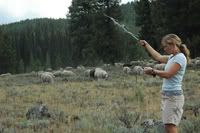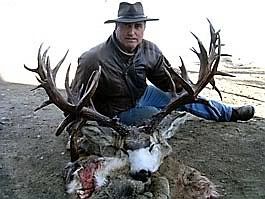A fire-by-fire breakdown is provided by Pahrump Valley Times. Nevada Department of Wildlife’s Game Bureau Chief Russ Mason was quoted as saying “These [2006 wildland] fires are an environmental disaster for the state of Nevada.”
Excerpt:
Areas of critically important mule deer transition and winter range and important sage grouse nesting and brood rearing habitat have been lost. In addition, chukar and pronghorn have been affected.
“Historically, fire intervals are between 100 and 150 years in these areas, and for some sagebrush environments in lower elevations, 200 to 300 years,” said Shawn Espinosa, Wildlife Biologist for the Nevada Department of Wildlife). Biodiversity is affected when these natural cycles are disrupted.
“We are now seeing fire return intervals on the order of 10 to 20 years – so the cheatgrass fire cycle is perpetuating itself,” he said. “More frequent fires preclude sagebrush seedlings that would come back after a fire from ever establishing,” said Espinosa.
One of the factors affecting fire intervals is invasive species.
In particular, non-native cheatgrass seems to have evolved to obliterate Nevada’s native vegetation. Cheatgrass is so named because it matures early and cheats native grasses, which emerge later, out of essential water and nutrients before the heat of summer sets in. It matures early and dries out early, creating fuel for fires. And it carries fire across areas between shrubs that would normally be bare.
“The potential for successful restoration is limited,” said Espinosa. Governmental agencies need to have luck on their side in the form of good precipitation, and the seeding must occur during the first year after a fire in order to out-compete cheat grass. Even then, the odds for sagebrush re-growth are low.” he said.
“We’ve seen sagebrush seed response in certain aspects – such as north facing slopes out of direct, all-day sunlight – and at certain elevations conducive for it to grow,” he said.
“Those are the sites we’re concentrating on. South facing slopes will predominantly convert to a cheatgrass environment,” Espinosa said. He noted that even when sage brush areas are reseeded, the overall germination rate is only about 20%.
With the basic fabric of the habitat changing, this doesn’t bode well for a lot of Nevada’s wildlife species. Sage grouse, a native species whose numbers are threatened, have lost numerous strutting grounds, used for mating.
“Over the past few years their nesting and critical brood-rearing habitat has been lost as well,” said Espinosa. “We’ve effectively lost these habitats for the next 30-50 years – conservatively,” he said.
The loss of critical deer winter range is being assessed, and the outlook is poor there as well. Areas burned were host to a number of species which will all suffer from the loss of habitat, including sage-dependent species like sage thrasher, vesper sparrow, and pygmy rabbit, as well as Lahontan cutthroat trout and a whole host of upland game species.
After last summer’s fires in Elko, the department put satellite tracking collars on 10 mule deer to track their movements. The information will help wildlife biologists learn how burned areas affect the deer’s journeys from summer to winter ranges. The data will also provide information to guide rehabilitation efforts to increase survival rates.
 According to the LA Times, there is a Mule Deer explosion on Coney Island, which shows what deer populations are capable of in the absence of predators. Someone(s) is apparently out to stir up some controversy, however, and is beheading deer with a knife.
According to the LA Times, there is a Mule Deer explosion on Coney Island, which shows what deer populations are capable of in the absence of predators. Someone(s) is apparently out to stir up some controversy, however, and is beheading deer with a knife.  Saturday, October 20, begins the Utah Rifle season for mule Deer.
Saturday, October 20, begins the Utah Rifle season for mule Deer.  Saturday, Oct 13 begins the Rifle Mule Deer Hunt in Washington state. Some units end on the 21st and others on the 27th.
Saturday, Oct 13 begins the Rifle Mule Deer Hunt in Washington state. Some units end on the 21st and others on the 27th.

 Wood River Valley resident Cindi Hillemeyer scans the surrounding Smoky Mountains with a handheld radio telemetry receiver in attempt to locate the Phantom Hill wolf pack’s two radio collared wolves Monday evening. This summer, Hillemeyer has been working as a volunteer with the Idaho Department of Fish and Game tracking the movements of the pack in an attempt to keep them away from bands of sheep that are grazing federal grazing allotments. Photo by Jason Kauffman
Wood River Valley resident Cindi Hillemeyer scans the surrounding Smoky Mountains with a handheld radio telemetry receiver in attempt to locate the Phantom Hill wolf pack’s two radio collared wolves Monday evening. This summer, Hillemeyer has been working as a volunteer with the Idaho Department of Fish and Game tracking the movements of the pack in an attempt to keep them away from bands of sheep that are grazing federal grazing allotments. Photo by Jason Kauffman 


